Kingdom Hearts 3 Review: Same Disney Charm, Same Convoluted Story
Kingdom Hearts III is a perfectly acceptable action/RPG, but the game's structure and story could have used a bigger refresh.
Why you can trust Tom's Guide
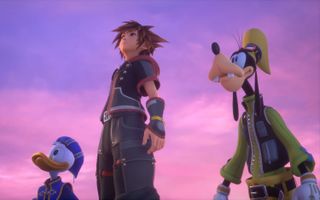
The first Kingdom Hearts game came out in 2002. In my head, that was about 10 years ago, but in actuality, 17 years have passed since Sora, Donald and Goofy's first adventure. Hearing that Squaresoft (not yet Square Enix) had announced an action/RPG combining Disney worlds with Final Fantasy characters was bizarre — but not nearly as bizarre as playing the game and discovering that the formula actually worked.
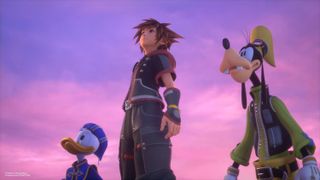
But a lot of time has passed since then. If you played the first Kingdom Hearts as a 13-year-old, you're now 30. From God of War to The Legend of Zelda, it seems like every major series has reinvented itself in order to stay relevant to gamers' changing tastes.

That's why it's strange that Kingdom Hearts III decidedly — almost defiantly — hasn't. Kingdom Hearts III is a gorgeous game with fluid combat that would have been impossible in 2002. But aside from its technical enhancements, this is a game that would have been right at home in the late PS2 era, alongside its two direct predecessors. It's still a straightforward action/RPG; it's still about a cast of affable characters in a story that's too convoluted for its own good; and it's still surprising just how much the series has pushed its Disney/Final Fantasy aspects to the wayside in favor of its own labyrinthine mythos.
MORE: Nintendo Switch vs. PS4 vs. Xbox One: Which Console Should You Get?
Kingdom Hearts III is a perfectly acceptable action/RPG, and it provides a reasonable sense of closure for the diehards who have followed the series this long. But at the same time, that's all it does. The gameplay, themes and narrative all cover well-worn territory, going for (admittedly impressive) breadth instead of depth. If you want to see how things wrap up after all this time, Kingdom Hearts III will provide the closure you're looking for, and that's about the biggest reason to recommend it.
Lights and sounds
For those of you who are just joining us: Kingdom Hearts III is the ninth game (yes, really) in the Kingdom Hearts series. Loosely speaking, the titles follow the adventures of Sora and Riku: two teenagers who traverse familiar Disney worlds by wielding legendary weapons called "Keyblades" against enemies known as the "Heartless." In this game, Sora once again teams up with frequent teammates Donald and Goofy in order to wrap up a whole lot of anime-inspired plot contortions across eight Disney worlds.
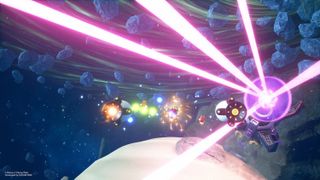
Seventeen years later, it's still enjoyable to leap into the air, juggle two or three Heartless with well-timed Keyblade strikes, air-dash to the other side of the battlefield, and finish them off with a Final Fantasy magic spell.
First: The combat is fun. It's not very deep or demanding (at least on Standard difficulty), but it will definitely keep you engaged for the 30-plus hours the game requires to complete. That may be damning the system with faint praise, but 17 years later, it's still enjoyable to leap into the air, juggle two or three Heartless with well-timed Keyblade strikes, air-dash to the other side of the battlefield, and finish them off with a Final Fantasy magic spell.
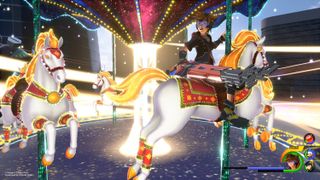
That is, however, pretty much all there is to it. You can customize your equipment and roster of magic spells, but once you set up the skills you like, you can button-mash your way to victory for everything but the boss fights. There's a reasonable variety of enemies to dispatch, but few of them require much strategy other than the occasional "attack from behind/above rather than head-on."

Instead, the game relies on special abilities — lots of them — to keep fights feeling fresh. You collect various Keyblades as the game progresses, and you can upgrade them with rare materials over time. Each one features a different alternate form, as well as a finishing move. But there's more! You can team up with party members for special attacks, use the environment for contextual skills, summon Disney characters who didn't quite merit their own world (like Wreck-It Ralph and Stitch) and even climb aboard a bunch of Disneyland rides to batter your enemies into submission.
MORE: The Best Headsets for Immersive Gaming
There's too much stuff going on in combat to ever get bored, but it's also hard to feel like you're in total control of it. Every battle turns into a drawn-out maelstrom of particle-effects-driven skills, to the point where it's often faster and easier to simply rely on standard attacks. This kitchen-sink approach takes the Links from Dream Drop Distance and the equippable Abilities from Birth by Sleep, then drops them into the mix — except those skills were largely to make up for the lack of party members, which you have in KHIII. It's a lot of stuff with comparatively little strategic value.
The House of Mouse
Then again, Kingdom Hearts isn't really about its combat system; it's about getting to explore your favorite Disney worlds and seeing their unexpected interactions with Final Fantasy characters. Or, at least, that was the original pitch. The amount of Final Fantasy characters has dried up within the past few years, dwindling from about dozen in Kingdom Hearts II down to just one in Birth by Sleep.

Unless you count the moogle shopkeeper and a few flashback sequences, there are no Final Fantasy characters in the game at all. I'm still not clear on why this is the case, since historically, they've been half the game's appeal.
However, there's a healthy crop of brand-new Disney worlds this time around, including Toy Story; Monsters, Inc.; Tangled; Frozen; and Big Hero 6. Returning worlds include Hercules, Pirates of the Caribbean and Winnie the Pooh — and that's about it. The levels themselves are huge and sprawling, but it's disappointing to end the major arc of the series without revisiting mainstays like Aladdin, The Nightmare Before Christmas and Tron. (And that really, really good Fantasia level from Dream Drop Distance.) My hat's off to Square Enix, however, for a very welcome cameo from Ratatouille, perhaps Pixar's most underrated film.

The worlds are a joy to behold, though, even if exploration and platforming can get pretty obtuse. (Two traditions that KHIII proudly embraces are the profoundly unhelpful camera, and Donald Duck never, ever slinging a healing spell when you need one.) The frozen mountains of Arendelle contrast beautifully with the verdant forests of Corona, while Port Royal — well, we'll get to Port Royal.
The Disney worlds are a joy to behold, even if exploration and platforming can get pretty obtuse.
Likewise, longtime composer Yoko Shimomura's music is up to her usual series standards, incorporating themes and motifs from the films to create catchy original compositions. (To nitpick just a little, though, Elsa belting out the entirety of "Let It Go" in the Frozen level feels just a little too self-indulgent, even by Kingdom Hearts standards.) And while I almost can't believe that 30-year-old Haley Joel Osment is still game to play a teenager, he infuses Sora with familiar warmth and optimism.
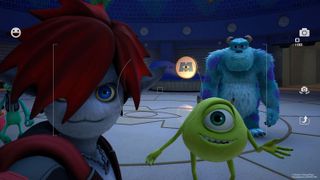
Despite the high production values, though, I couldn't shake the feeling that the formula hadn't changed all that much. You'll still travel to a new Disney world, get acquainted with its characters, experience a heavily truncated version of the movie's main story and learn about a tangential connection to the game's narrative. (Spoiler: It's usually something about friendship, or love, or hearts.) Then you'll leave, go into a brief space-shooter section en route to the next world, and repeat the whole process again.
I couldn't quite put my finger on what was wrong with the process until I wound up in Port Royal for the Pirates of the Caribbean level. The story here is based on the third film, At World's End, which was not a very good movie by any stretch. And yet, once the level got going, I was legitimately bowled over.

The Pirates level is not just content to let you relive a few movie moments and call it a day. Instead, it built a whole naval combat mechanic from scratch. You command your own ship, the Leviathan, which you can sail around an open-world Caribbean, fighting off enemy ships, hunting for treasure, and improving the hull and cannons. It's like a kid-friendly Assassin's Creed IV, and I gladly spent a few extra hours hunting down doodads and fighting massive enemy fleets. The level ends with an action-packed confrontation with a major villain, in which you get to make use of both your ship- and ground-combat abilities.
Had Square Enix made every level as memorable as The Caribbean, Kingdom Hearts could have been one of the most ambitious games of its generation.
And then, I was off to San Fransokyo, for yet another "follow the movie heroes, learn something about friendship" episode.
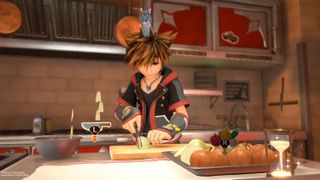
The Caribbean level demonstrated everything that Kingdom Hearts should be, capturing a movie's unique look and feel through gameplay rather than just narrative. Had Square Enix done something similar for every level, Kingdom Hearts could have been one of the most ambitious games of its generation.
Light and darkness
I've barely even touched upon Kingdom Hearts III’s story, but it's hard to even set up unless you know 17 years' worth of complicated backstory (and are willing to sit through a decent amount of 20-minute cutscenes). It's enough to say that if you've followed the series this long, you'll be able to follow most of what's going on, and if you haven't, then the narrative is mostly just going to be an excuse to see your favorite Disney characters.
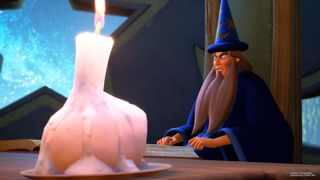
I can say, at least, that the game wraps up most of the franchise's lingering story threads pretty nicely, and there's some heartfelt character interaction, especially toward the end. But "wrapping up" is definitely the name of the game here. I'm not even sure you could say that Kingdom Hearts III has its own story; it's almost entirely just following every outstanding plot knot to its logical conclusion. How much you'll enjoy that depends on how much you're invested in the series.
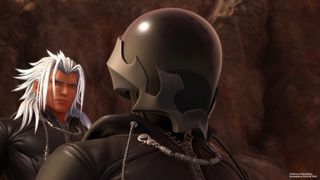
Ultimately, Kingdom Hearts III was satisfying in the same way that a decent TV series finale is satisfying. Like Buffy the Vampire Slayer, or Seinfeld, or Star Trek: Voyager, Kingdom Hearts' best days were behind it, but it managed to end on a moderately high note, rather than dragging things out well past the point of interest. (I'm looking at you, How I Met Your Mother.)
So that's Kingdom Hearts III: it's charming, it's frustrating, it's accessible, it's convoluted, it's ambitious and it's safe. And, as a result, it's not always the most coherent game. But if you've stuck with the series this long, you may as well see how it ends. And if you haven't, you may want to take Elsa's advice and simply "let it go."
Credit: Square Enix
Sign up to get the BEST of Tom’s Guide direct to your inbox.
Upgrade your life with a daily dose of the biggest tech news, lifestyle hacks and our curated analysis. Be the first to know about cutting-edge gadgets and the hottest deals.
Marshall Honorof is a senior editor for Tom's Guide, overseeing the site's coverage of gaming hardware and software. He comes from a science writing background, having studied paleomammalogy, biological anthropology, and the history of science and technology. After hours, you can find him practicing taekwondo or doing deep dives on classic sci-fi.

